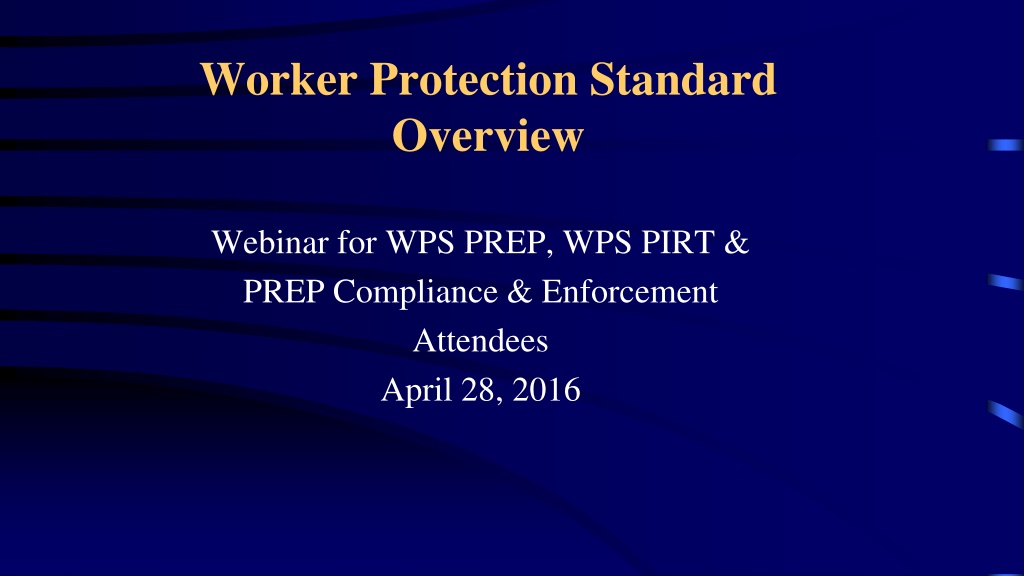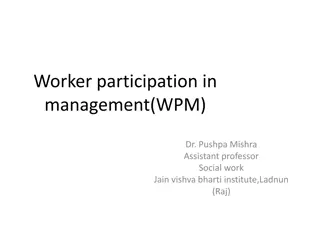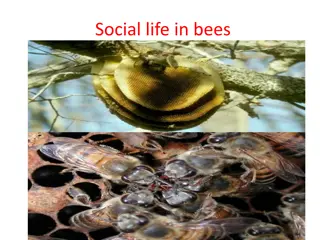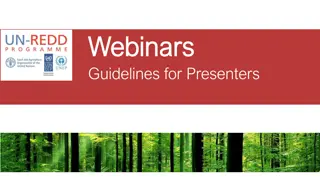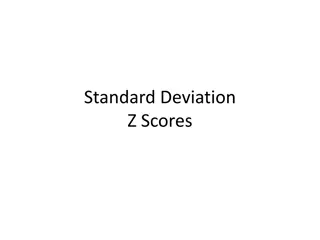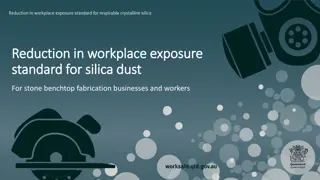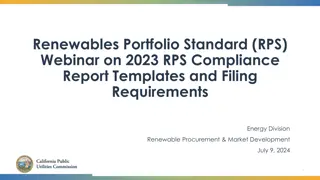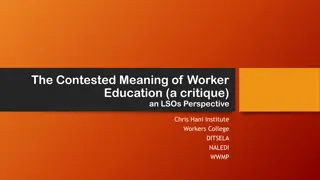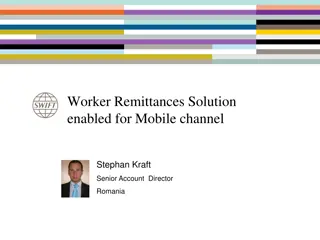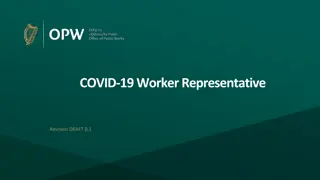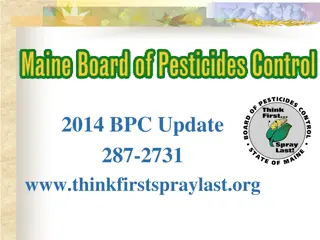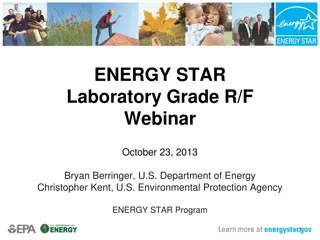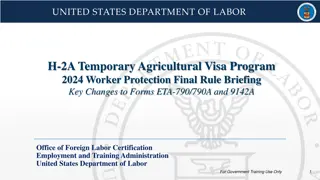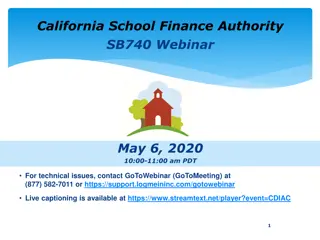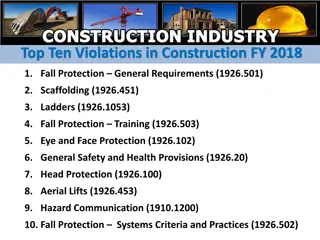Worker Protection Standard Overview Webinar for WPS Compliance
Delve into the Worker Protection Standard (WPS) framework, revised rules, exemptions, and more in this comprehensive webinar tailored for WPS PREP, PIRT, and PREP Compliance and Enforcement attendees. Explore key aspects such as WPS basics, relationship with OSHA regulations, training requirements, and the significance of OSHA equivalency. Uncover valuable insights for ensuring workplace safety and compliance with regulatory standards.
Download Presentation

Please find below an Image/Link to download the presentation.
The content on the website is provided AS IS for your information and personal use only. It may not be sold, licensed, or shared on other websites without obtaining consent from the author. Download presentation by click this link. If you encounter any issues during the download, it is possible that the publisher has removed the file from their server.
E N D
Presentation Transcript
Worker Protection Standard Overview Webinar for WPS PREP, WPS PIRT & PREP Compliance & Enforcement Attendees April 28, 2016
Agenda WPS 101 Relationship between WPS & OSHA regs WPS framework Background and basics Revised WPS General: Changes to rule structure, implementation dates Scope and Applicability: Including exceptions to applicability
Agenda Revised WPS (continued) Definitions Inform: Training, establishment-specific info, knowledge of labeling Mitigate: Decontamination supplies, emergency assistance Protect: Minimum age, PPE requirements Exemptions & exceptions: Exemptions, PPE exceptions, early entry exemptions
Agenda Topics we will not cover on this webinar Application exclusion zone / protections during applications Respirator medical evaluation, fit test and training Hazard communication Pesticide safety poster Notification Display pesticide safety info & safety data sheets, designated representative Information exchange
Questions Email questions to prep.sla@wsu.edu Subject line of email: WPS webinar question Identify which course you are attending WPS PIRT Compliance and Enforcement PREP WPS Implementation PREP If possible, note the WPS subject area Submit question(s)
WPS 101 Relationship between WPS & OSHA regulations WPS framework Background and basics
Relationship Between WPS and OSHA Regulations
Why OSHA Equivalency Matters Under its statutory authority, OSHA promulgated a Hazard Communication Standard (HCS) (29 CFR 1910.1200) to protect employees from general chemical hazards in the workplace OSHA also establishes industry, chemical, and process-specific standards to address workplace hazards that warrant additional regulatory measures to ensure employees occupational safety and health
Why OSHA Equivalency Matters OSHA s HCS covers all industries in which an employee may be exposed to a chemical hazard in the workplace - except as limited by section 4(b)(1) of the Occupational Safety and Health Act, which prohibits OSHA from regulating working conditions or hazards where other federal agencies exercise statutory authority to prescribe or to enforce standards for occupational safety and health
EPA and OSHA Roles EPA has stated the intended reach of the WPS is limited to occupational safety for pesticides and OSHA is not preempted from regulating any non-pesticide chemical or other workplace hazards in agriculture OSHA established a policy not to cite employers covered under the WPS for pesticide-related HCS standards. The policy defers to EPA s regulatory authorities for protection of handlers and workers on establishments covered by the WPS, as well as pesticide labeling and use and certification of pesticide applicators EPA and OSHA agreed OSHA s Field Sanitation Standard addresses general sanitary standards, while EPA s WPS decontamination requirements are specific to pesticide hazards so no preemption issues exists
WPS 101: Background and WPS Basics
WPS Framework Inform Protect Mitigate
WPS Framework Inform Training Pesticide safety information Notification Information exchange
WPS Framework Protect Restricted entry intervals (REIs) Personal protective equipment (PPE) Application exclusion zones (AEZs) Suspend applications
WPS Framework Mitigate Routine decontamination supplies Emergency eyewash Emergency assistance
WPS 101: Background and Basics Relationship Between Pesticide Labeling & WPS WPS requirements incorporated onto labeling by WPS reference statement contained in the Agricultural Use Requirements box
WPS 101: Background and Basics Relationship Between Pesticide Labeling & WPS The labeling has product-specific requirements to protect workers and handlers WPS has instructions on how to implement the requirements WPS requirements are too lengthy to place on every label, e.g., requirements for pesticide safety training, hazard communication, posting/notification, decontamination, and emergency assistance Pesticide Labeling Length of the restricted entry interval (REI) What PPE must be worn WPS How to notify workers about the REI (oral or field posting) Providing, maintaining, and ensuring proper fit of PPE
WPS 101: Background and Basics Relationship Between Pesticide Labeling & WPS Under FIFRA section 12(a)(2)(G), it is unlawful for any person to use any registered pesticide in a manner inconsistent with its labeling When this part is referenced on a label, users must comply with all of its requirements, except those that are inconsistent with product-specific instructions on the pesticide product labeling
WPS 101: Background and Basics Relationship Between Pesticide Labeling & WPS Part 156 Subpart K - Worker Protection Statements establishes WPS labeling requirements Product specific labeling requirements (handler PPE, REIs, early entry PPE, etc.) have been established through OPP s risk assessment process in combination with EPA s Label Review Manual (LRM)
WPS 101: Background and Basics KEY POINT: There are no changes to Part 156 Subpart K, Worker Protection Statements No label changes needed to implement new WPS revisions No change in scope of products covered by the rule only agricultural use pesticides (for crop uses) covered Current WPS labeling requirements remain the same WPS compliance monitoring focus should be on ag use inspections for WPS use requirements rather than marketplace or producer establishment inspections
Revised WPS Part 1 General Changes to rule structure Implementation dates Scope and applicability Including exceptions to applicability Definitions
Changes to WPS Rule Structure (40 CFR 170)
Current WPS Rule Structure DescriptionCitation Subpart A: General Provisions 170.1-170.9 Scope & purpose; definitions; compliance dates; general duties & prohibited actions; violations Subpart B: Standard for Workers 170.102-170.160 Applicability, exceptions & exemptions; restrictions during & after application; notification; training; post pesticide safety & pesticide application info; decontamination; emergency assistance Subpart C: Standard for Handlers 170.202-170.260 Applicability, exceptions & exemptions; restrictions during application; info exchange; training; knowledge of labeling & site-specific info; post pesticide safety info; PPE; decontamination; emergency assistance
Revised WPS Rule Structure Description Citation Subpart D: General Provisions Scope & purpose; applicability; definitions; employer duties (including emergency assistance); display pesticide safety, application & hazard info; prohibited actions; violations Subpart E: Requirements to Protect Workers Training; establishment-specific info; restrictions during & after application; notification; decontamination Subpart F: Requirements to Protect Handlers Training; knowledge of labeling & establishment-specific requirements during applications; PPE; decontamination flushing supplies Subpart G: Exemptions, Exceptions & Equivalency 170.601-170.609 Exemptions; early-entry exceptions; exceptions to PPE; equivalency requests 170.301-170.317 170.401-170.411 170.501-170.509 info; & eye
Implementation Dates: 2017 170.2 Implementation and expiration dates. (a) Implementation date. Beginning January 2, 2017, the requirements of 170.301 through 170.609 of this part shall apply to any pesticide product that bears the statement Use this product only in accordance with its labeling and with the Worker Protection Standard, 40 CFR part 170 . (b) Expiration date. Sections 170.1 through 170.260 of this part shall expire on, and will no longer be effective after January 2, 2017.
Implementation Dates: 2018 Sections 170.311(a)(3), 170.401(c)(3), 170.501(c)(3), and 170.505(b): The implementation date for these provisions is delayed until January 2, 2018 The implementation date for ALL other WPS requirements is January 2, 2017 Requirements in listed sections: Revised content of pesticide safety information New content for worker & handler training Handler must suspend application if worker or other person is in application exclusion zone
WPS 101: Scope and Applicability Who is responsible for providing WPS protections? Agricultural employers on crop-producing agricultural establishments Commercial pesticide handling establishment employers Who is protected? Workers people employed to perform work activities related to production of agricultural plants Pesticide handlers people employed to mix, load or apply pesticides for use on agricultural establishments in the production of agricultural plants Other persons during pesticide applications
WPS 101: Scope and Applicability Scope: Who is covered? Approximately 890,000 agricultural establishments (farms, forests, nurseries) Approximately 45,000 commercial pesticide handling establishments (CPHEs) No expansion of WPS scope with revisions No significant changes to excepted uses (i.e., livestock-related uses, post-harvest uses, lawn and ornamental uses, etc.)
WPS 101: Scope and Applicability Key Provision 170.303(a): This regulation applies whenever a pesticide product bearing a label requiring compliance with this part is used in the production of agricultural plants on an agricultural establishment, except as provided in paragraphs (b) and (c) of this section.
WPS 101: Scope and Applicability Keys to WPS applicability: Use of a WPS-labeled pesticide product on an agricultural establishment directly related to the production of an agricultural plant Employment of workers or handlers Definitions of agricultural establishment, agricultural plant, and employ are important definitions to establishing the scope of rule
WPS Exceptions to Applicability 170.303(b) The WPS does not apply on agricultural establishments when pesticides are used as follows: As part of government-sponsored public pest control programs over which the owner, agricultural employer and handler employer have no control (e.g., mosquito abatement and Mediterranean fruit fly eradication programs) On plants other than agricultural plants, which may include plants in home fruit and vegetable gardens and home greenhouses, and permanent plantings for ornamental purposes, such as plants that are in ornamental gardens, parks, public or private landscaping, lawns or other grounds that are intended only for aesthetic purposes For control of vertebrate pests, unless directly related to the production of an agricultural plant
WPS Exceptions to Applicability 170.303(b) The WPS does not apply on agricultural establishments when pesticides are used as follows: As attractants or repellents in traps On the harvested portions of agricultural plants or on harvested timber For research uses of unregistered pesticides On pasture and rangeland where the forage will not be harvested for hay In a manner not directly related to the production of agricultural plants, including, but not limited to livestock pest control, structural pest control and control of vegetation in non-crop areas
WPS Exceptions to Applicability Key Provision 170.303(c): Where a pesticide s labeling-specific directions for use or other labeling requirements are inconsistent with requirements of the WPS, users must comply with the pesticide product labeling, except as provided for in exemptions and exceptions listed in sections 170.601, 170.603 and 170.607 of the WPS.
Definitions (170.305) Added definitions to rule for the following terms: Application exclusion zone, closed system, commercial pesticide handler employer, designated representative, employ, enclosed cab, enclosed space production, labor contractor, outdoor production, personal protective equipment, safety data sheet, use and worker housing area Revised the following key definitions: Agricultural establishment, agricultural plant, handler, immediate family and worker Deleted the following definitions: Commercial production (proposed), entry-restricted area (proposed), farm, forest, forest operation (proposed), greenhouse and nursery
Definitions (170.305) Key Definitions / Revisions Agricultural establishment and agricultural plant Application exclusion zone Commercial pesticide handler employer Designated representative Employ Enclosed space production and outdoor production Immediate family Safety data sheet Use, as in to use a pesticide
Definitions (170.305) Agricultural establishment Agricultural establishment means any farm, forest operation, or nursery engaged in the outdoor or enclosed space production of agricultural plants. An establishment that is not primarily agricultural is an agricultural establishment if it produces agricultural plants for transplant or use (in part or their entirety) in another location instead of purchasing the agricultural plants.
Definitions (170.305) Agricultural plant Agricultural plant means any plant, or part thereof, grown, maintained, or otherwise produced for commercial purposes, including growing, maintaining or otherwise producing plants for sale or trade, for research or experimental purposes, or for use in part or their entirety in another location. Agricultural plant includes, but is not limited to, grains, fruits and vegetables; wood fiber or timber products; flowering and foliage plants and trees; seedlings and transplants; and turf grass produced for sod. Agricultural plant does not include pasture or rangeland used for grazing.
Definitions (170.305) Application exclusion zone Application exclusion zone means the area surrounding the application equipment that must be free of all persons other than appropriately trained and equipped handlers during pesticide applications.
Definitions (170.305) Commercial pesticide handler employer Commercial pesticide handler employer means any person, other than an agricultural employer, who employs any handler to perform handler activities on an agricultural establishment. A labor contractor who does not provide pesticide application services or supervise the performance of handler activities, but merely employs laborers who perform handler activities at the direction of an agricultural or handler employer, is not a commercial pesticide handler employer.
Definitions (170.305) Designated representative Designated representative means any persons designated in writing by a worker or handler to exercise a right of access on behalf of the worker or handler to request and obtain a copy of the pesticide application and hazard information required by 170.309(h) in accordance with 170.311(b) of this part.
Definitions (170.305) Employ Employ means to obtain, directly or through a labor contractor, the services of a person in exchange for a salary or wages, including piece rate wages, without regard to who may pay or who may receive the salary or wages. It includes obtaining the services of a selfemployed person, an independent contractor, or a person compensated by a third party, except that it does not include an agricultural employer obtaining the services of a handler through a commercial pesticide handler employer or a commercial pesticide handling establishment.
Definitions (170.305) Enclosed space production Enclosed space production means production of an agricultural plant indoors or in a structure or space that is covered in whole or in part by any nonporous covering and that is large enough to permit a person to enter.
Definitions (170.305) Outdoor production Outdoor production means production of an agricultural plant in an outside area that is not enclosed or covered in any way that would obstruct the natural air flow.
Definitions (170.305) Immediate family Immediate family is limited to the spouse, parents, stepparents, foster parents, father in law, mother inlaw, children, stepchildren, foster children, sons inlaw, daughters in law, grandparents, grandchildren, brothers, sisters, brothers in law, sisters in law, aunts, uncles, nieces, nephews, and first cousins. First cousin means the child of a parent s sibling, i.e., the child of an aunt or uncle.
Definitions (170.305) Safety data sheet (SDS) Safety data sheet has the same meaning as the definition at 29 CFR 1900.1200(c). OSHA definition: Safety data sheet (SDS) means written or printed material concerning a hazardous chemical that is prepared in accordance with paragraph (g) of this section.
Definitions (170.305) Use, as in to use a pesticide Use, as in to use a pesticide means any of the following: (1) Pre application activities, including, but not limited to: (i) Arranging for the application of the pesticide. (ii) Mixing and loading the pesticide. (iii) Making necessary preparations for the application of the pesticide, including responsibilities related to worker notification, training of workers or handlers, providing decontamination supplies, providing pesticide safety information and pesticide application and hazard information, use and care of personal protective equipment, providing emergency assistance, and heat stress management. (2) Application of the pesticide. (3) Post application activities intended to reduce the risks of illness and injury resulting from handlers' and workers' occupational exposures to pesticide residues during and after the restricted entry interval, including responsibilities related to worker notification, training of workers or early entry workers, providing decontamination supplies, providing pesticide safety information and pesticide application and hazard information, use and care of personal protective equipment, providing emergency assistance, and heat stress management. (4) Other pesticide related activities, including, but not limited to, transporting or storing pesticides that have been opened, cleaning equipment, and disposing of excess pesticides, spray mix, equipment wash waters, pesticide containers, and other pesticide containing materials.
Definitions (170.305) Preamble, XVIII. General Revisions, C. Definitions, 8. Use (p 67551) EPA interprets arranging for application of the pesticide as used in 170.9(a) and 170.305 as a means of assuring that the entities (generally the agricultural employer or handler employer) with the most authority and control over WPS compliance would be legally responsible for WPS compliance. EPA does not interpret arranging for application of the pesticide as making subordinate persons who merely perform the clerical functions of arranging for application of the pesticide liable for WPS compliance.
